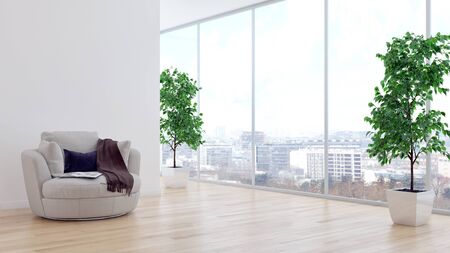Understanding Minimalist Feng Shui
Minimalist Feng Shui is an adaptation of traditional Feng Shui principles designed to fit the modern American lifestyle, especially in homes with open floor plans. Unlike the intricate and sometimes ornate approach of classic Feng Shui, minimalist Feng Shui focuses on simplicity, clarity, and intentional design. This means creating spaces that feel open, calm, and purposeful, while still supporting positive energy flow throughout your home.
Key Differences: Minimalist vs. Traditional Feng Shui
| Traditional Feng Shui | Minimalist Feng Shui |
|---|---|
| Emphasizes detailed arrangements and symbolic objects | Focuses on less clutter and fewer decorative items |
| Uses a wide range of colors, materials, and shapes | Picks a limited color palette and simple forms |
| Relies on specific furniture placement for energy flow (Chi) | Prioritizes openness and clear pathways for easy movement |
| Might include many traditional cures or charms | Embraces intentional pieces that have meaning or function |
Simplicity in Design for Modern Homes
American homes often feature open floor plans that combine living, dining, and kitchen areas into one large space. Minimalist Feng Shui fits perfectly with this layout by recommending:
- Decluttering: Keep only what you need or love. Less is more when it comes to both furniture and decor.
- Functional Zones: Use rugs, lighting, or furniture arrangement to subtly define spaces without building walls.
- Natural Light: Let sunlight fill your home to boost energy and create a sense of spaciousness.
- Intentional Placement: Choose key pieces like a sofa or dining table mindfully so they encourage connection and comfort.
The Benefits of Minimalism in Feng Shui
This approach not only makes your home look clean and modern but also supports relaxation, focus, and well-being. By blending minimalist principles with open floor plans, you create a balanced space that feels both welcoming and harmonious—perfect for today’s American lifestyle.
2. The Appeal of Open Floor Plans in American Homes
Open floor plans have become increasingly popular in modern American homes, reflecting a shift toward more relaxed and flexible living spaces. This trend aligns perfectly with minimalist Feng Shui principles, as both emphasize simplicity, flow, and harmony within the home environment.
Why Open Floor Plans Are Gaining Popularity
Many homeowners are drawn to open floor plans because they break down traditional barriers between rooms, creating a sense of spaciousness and connectivity. Instead of having separate rooms for the kitchen, dining area, and living room, these spaces flow into one another. This design approach offers several advantages:
| Benefit | Description |
|---|---|
| Increased Natural Light | With fewer walls blocking windows, sunlight can travel throughout the space, making the home feel brighter and more inviting. |
| Flexible Use of Space | The open layout allows families to rearrange furniture or change how areas are used without being restricted by fixed walls. |
| Enhanced Social Interaction | An open plan makes it easier for everyone to be together. Whether cooking, working, or relaxing, family members can connect more easily. |
| Modern Aesthetic | The clean lines and uncluttered look of open layouts appeal to those who appreciate minimalism and contemporary style. |
Creating Communal Living Spaces
One of the main reasons open floor plans are so appealing is their ability to foster communal living. In many American households, the kitchen is the heart of the home. With an open concept, the kitchen seamlessly blends with dining and living areas, encouraging shared activities and conversations. This setup not only supports family bonding but also makes entertaining guests easier and more enjoyable.
How Open Floor Plans Complement Minimalist Feng Shui
The seamless flow of energy, or chi, is a core principle in Feng Shui. Open layouts support this idea by reducing clutter and obstacles that might block energy movement. By integrating minimalist design elements—such as neutral color palettes, simple furnishings, and intentional decor—homeowners can further enhance the harmonious atmosphere that both modern design and Feng Shui aim to achieve.

3. Harmonizing Feng Shui with Open Layouts
Making Feng Shui Work in Open Floor Plans
Modern American homes often feature open floor plans that blend the kitchen, dining, and living areas into one large space. While these layouts create a sense of spaciousness and encourage family interaction, they can present challenges for traditional Feng Shui, which values clear boundaries and balanced energy. Here are some practical ways to bring minimalist Feng Shui principles into your open home without sacrificing style or comfort.
Zoning: Defining Spaces Without Walls
Feng Shui teaches that every area of your home should have a purpose. In open layouts, you can use subtle zoning techniques to define each space’s function while keeping the flow natural. Consider using rugs, lighting, or furniture arrangement to visually separate the living, dining, and kitchen areas. This helps maintain order and balance without needing physical barriers.
| Technique | How It Works | Feng Shui Benefit |
|---|---|---|
| Area Rugs | Differentiates zones by color or texture | Anchors energy in each space |
| Lighting | Pendants over dining tables, lamps in living areas | Defines activity zones and improves energy flow |
| Furniture Placement | Sofas or shelves used as gentle dividers | Creates boundaries without blocking light or movement |
Smart Furniture Placement for Flow and Balance
The way you arrange your furniture can greatly influence the energy (or “chi”) in an open-plan home. Aim for a layout where pathways are clear and there is no direct line from the front door straight through to the back of the house, as this could allow good energy to rush out too quickly. Place sofas so you can see the main entrance from where you sit—this offers a sense of security and welcome, both key elements in Feng Shui.
Tips for Arranging Furniture:
- Avoid blocking windows: Letting natural light in supports healthy chi.
- Create conversation circles: Arrange seating so people face each other easily.
- Use low shelves: These divide space but keep sight lines open.
- Add plants strategically: Greenery brings life energy and softens hard edges between zones.
Maintaining Flow and Balance
In minimalist Feng Shui, less is often more. Keep surfaces clutter-free and choose decor that feels intentional. Mirrors can be used to reflect light and expand a space’s feel but avoid placing them directly facing doors. Try balancing larger pieces—like sofas or bookcases—on opposite sides of a room to keep things feeling steady rather than lopsided.
Cultivating a Sense of Calm
- Select calming colors: Soft neutrals work well in American homes with open floor plans.
- Edit accessories: Display only items that spark joy or hold meaning.
- Encourage movement: Make sure there’s a clear path from one area to another for smooth chi flow.
This approach allows you to enjoy the airy openness of modern American design while still benefiting from the harmony and positive energy of minimalist Feng Shui principles.
4. Key Elements to Consider: Light, Color, and Materials
When blending minimalist Feng Shui with open floor plans in modern American homes, focusing on natural light, calming colors, and intentional materials can make a big difference. These elements not only enhance the clean look of minimalism but also support positive energy flow throughout your space.
Natural Light: The Heart of Positive Energy
Open floor plans naturally invite more sunlight into your home. In Feng Shui, natural light is essential for uplifting energy (Qi). Try maximizing daylight by using large windows, skylights, or even glass doors. Sheer curtains or no window coverings at all will help keep the space feeling bright and airy. If you need privacy, opt for light-filtering shades instead of heavy drapes.
Soothing Color Palettes
The right colors set the mood and influence how energy moves around your home. Minimalist design often uses neutral shades, which aligns well with Feng Shui’s preference for peaceful environments. Below is a quick guide to choosing colors that fit both styles:
| Color Family | Feng Shui Meaning | Minimalist Appeal | How to Use |
|---|---|---|---|
| White & Soft Gray | Clarity, purity | Crisp, clean look | Main walls and larger surfaces |
| Earth Tones (beige, taupe) | Stability, grounding | Warmth without clutter | Floors, accent walls, rugs |
| Pale Blues & Greens | Calm, renewal | Freshness and tranquility | Bedding, cushions, art pieces |
| Black (in moderation) | Sophistication, depth | Modern contrast | Picture frames, small furniture pieces |
Intentional Material Choices for Flow and Harmony
The materials you choose shape both the look and feel of your home. Open floor plans benefit from materials that create a sense of unity while also supporting good Feng Shui energy flow:
- Wood: Adds warmth and connection to nature; use it for floors or shelving.
- Glass: Maximizes light and keeps spaces open; great for tabletops or room dividers.
- Cotton & Linen: Softens hard lines; use in throws or window treatments.
- Metal: Brings clarity and order; works well in minimalist lighting fixtures or hardware.
- Avoid clutter: Minimalism thrives on keeping surfaces clear—store items out of sight when possible.
Tying It All Together in Your Home
The magic happens when you combine these elements: let sunlight pour in, stick to soothing color palettes, and be thoughtful with every material you bring into your space. This approach helps your open floor plan feel welcoming and balanced—true to both minimalist style and the principles of Feng Shui.
5. Adapting Feng Shui for American Lifestyles
Personalizing Feng Shui in Open Floor Plans
Open floor plans are a hallmark of modern American homes, bringing families and friends together in shared, airy spaces. While traditional Feng Shui often focuses on defined rooms and boundaries, you can still achieve balance, harmony, and wellness by adapting these principles to fit your unique lifestyle and preferences.
Tailored Tips for American Homeowners
| Feng Shui Principle | American Lifestyle Adaptation | Wellness Benefit |
|---|---|---|
| Clear Pathways | Arrange furniture to create easy movement between kitchen, dining, and living areas—avoid cluttered walkways. | Promotes energy flow, reduces stress. |
| Natural Light | Maximize windows and use light curtains; place mirrors strategically to reflect daylight deeper into the space. | Lifts mood, boosts vitality. |
| Personal Touches | Add family photos or meaningful art in the living area, keeping personal items organized and intentional. | Cultivates positive emotions and comfort. |
| Balanced Elements | Blend wood (plants or wooden décor), metal (light fixtures), water (fountains), fire (candles), and earth (ceramics) through accessories or accent pieces. | Enhances harmony and well-being. |
| Zoning Spaces | Use rugs, open shelving, or plants to visually define separate activity areas without adding walls. | Maintains openness while supporting focus and relaxation. |
Cultural Preferences: Making Feng Shui Your Own
You don’t have to follow every traditional Feng Shui rule—what matters is creating an environment that feels good for you and your household. If you love bright colors or bold artwork, incorporate them thoughtfully. If you prefer a cozy reading nook by a window, position it where natural light flows. The goal is to blend Feng Shui’s foundational ideas with your personal style so your home supports both your cultural values and daily routines.
Simple Steps to Get Started
- Edit regularly: Declutter open spaces weekly for a fresh start.
- Celebrate nature: Bring in plants or fresh flowers to energize your space.
- Create comfort zones: Add soft textiles like throws or pillows for inviting relaxation spots within the open plan.
- Scent matters: Use essential oils or candles with scents you love to enhance the atmosphere.
- Stay flexible: Rearrange furniture seasonally to refresh energy and adapt to changing needs.
This approach lets you enjoy the best of both worlds—modern American design with the timeless benefits of Feng Shui for a harmonious, welcoming home.


